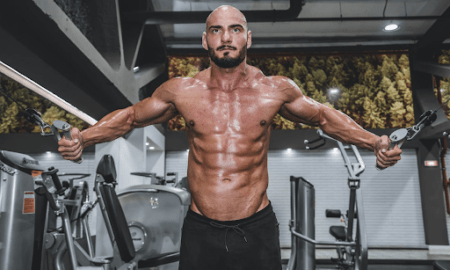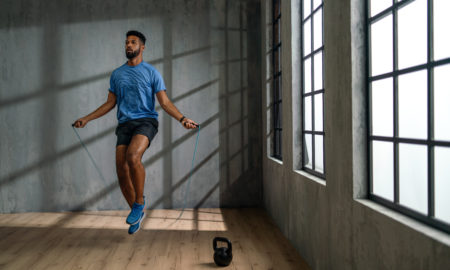
While parents have no qualms about letting their children participate in such contact sports as hockey, football, soccer and lacrosse at a very early age—sometimes as young as six—they completely reject the idea of having their offspring take part in a weight-training program. Way too dangerous, they contend. Yet they actually encourage their sons to blast full-speed into an opponent at a football game or hockey match. Even more insane is the huge popularity of skateboarding, in which very young boys often do acrobatic maneuvers 40 feet above terra firma. Currently more than 12 million athletes take part in that risky sport, and the majority are under 10 years old. So it’s okay to skateboard but taboo to lift weights. Totally illogical. It’s much safer to weight-train in a controlled fashion than to be gang-tackled or to crash and burn on a skateboard.
The notion that any type of weight training is harmful to a young, undeveloped body is supported by the medical community. Most authorities recommend waiting until youngsters are in their teens before starting a lifting program. It has to do with growth plates. The contention is that if youngsters lift weights, they’ll damage the growth plates in the long bones and that will adversely affect their height. Makes sense, right? Or does it? I’ve never bought it. If that were the case, then no one should lift weights who hasn’t reached age 20 because growth is still occurring till then. Plus, I’ve never read any scientific studies that supported the allegation. I have, however, read several studies conducted on youngsters in Europe who started training very early, and none reported any damage to the growth plates.
I think it’s simply a concept that’s been around for so long, everyone assumes it must be fact, even though no hard evidence to substantiate it has ever surfaced. Otherwise it would be in every magazine, newspaper and news report across the country. I happen to believe the exact opposite—resistance training done under proper supervision helps stimulate growth in bones and muscles.
It wasn’t many years ago that children growing up on farms did their share of the work even before they started elementary school. As they grew older, they did more, and some of the chores were quite strenuous. It turned out that farm boys were invariably bigger and much stronger and more athletic than their nonfarm classmates. They became the cornerstones of the sports teams and didn’t suffer in the slightest from the hard work imposed on them every day. In addition, the young farmers grew to be taller than their parents.
What people fail to recognize is that the hard work involved in the daily operation of a farm was basically a form of strength training. Before much of the labor was mechanized, it entailed a great deal of heavy lifting, pulling and pushing. Some of the programs used by strength athletes in sports now include many of the same things done by farmers and other laborers as part of their jobs.
Even if parents do understand that weight training can be beneficial to their child, they still have lots of concerns: How young can kids start on a routine? Should they do high reps and use only light weights? What exercises should they include in their routines, and which ones should they avoid? How often should they train and for how long? All are valid questions.
The European sports community is light-years ahead of the United States in regard to training youngsters. In Europe it’s been demonstrated that very young boys and girls can derive positive benefits from a systematic, well-supervised strength-training regimen—and safely. When I was the editor of Strength & Health in the late 1960s, I exchanged copies of the magazine for closely held information about what the Russian Olympic lifters were doing at the time. My pen pal sent me a comprehensive study dealing with young lifters, some just eight years of age.
What many people fail to grasp is that Russians cherish their children just as much as Americans do, so a study was done to find out if, in fact, weight training might indeed be harmful over the long term. Over a 10-year span it compared weightlifters with swimmers and concluded that there was no significant difference between the overall development of the two groups, except that the weight-trained athletes had more muscle mass and better posture. There was no evidence of any disruption in the growth process in either group.
So basically, a youngster can begin to do resistive training at almost any age. The guideline I use is not chronology but maturity level. How a youngster takes direction and maintains discipline is a better gauge than age. Some eight-year-olds are more focused than the majority of 14-year-olds.
Several excellent coaches in this country believe that’s it’s better to start boys on strength training when they’re quite young, before their interest turns to girls, cars, girls. One of them is Jim Moser, a former Olympic lifter whom I started training when he was 14. He has two sons, James and Willy. James started tagging along with his father to the gym when he was nine. Jim is part owner of three Valley Isle Fitness Centers on Maui, so it was only natural for James to start playing with the weights. By age 12 he was doing some serious lifting and at 16 had risen to the top echelon in the sport of Olympic weightlifting. At that point he’d already won the Junior Olympics four times, the Junior Nationals twice, held numerous National School Age Records and come in second at the Junior Pan Ams in Colombia. At 17 he placed third in the Senior Nationals and has personal bests of 363 in the snatch and 410 in the clean and jerk, at a bodyweight of 206. It certainly didn’t interfere with his growth pattern. He’s 6’2”, a good six inches taller than his father. Now 18, he’s considered one of our best hopes on the international scene.
Willy is nine years younger than James, and very early in his life he began watching his big brother train and started to mimic his moves. I’ve seen videos of Willy snatching and jerking a broomstick when he was five years old. His father didn’t push him into lifting. Willy did it on his own. It was merely another form of play, and kids possess a wealth of energy to expend on various physical activities. By six he was training regularly and, like James, enjoyed the Olympic lifts. In 2007 he won the Junior Nationals in Knoxville. At eight he was competing against boys three years older, which is a huge age gap at that stage of life. He has done a 54-pound snatch and 88-pound clean and jerk—more than he weighs.
There are other examples. Mike Burgener is one of the very best Olympic-lifting coaches in the country, and he started his sons at an early age on strength-training programs. Currently, Casey is the number-one heavyweight in the United States with lifts of 390 in the snatch and 480 in the clean and jerk. Norik Vardanian is another who started lifting when he was quite young. He, Casey and James are our hopes for the future in Olympic lifting.
So there’s evidence in our own country that it’s okay for youngsters to embark on a strength routine. It needs to be noted that they were all trained by fathers who had extensive experience in the sport and who understood the many salient aspects of coaching a young athlete. Most of all, they put the kids’ health and welfare ahead of everything else. That isn’t always the case. Quite often a father is so intent on making his son strong, he’ll push him beyond his limits. Or at the other extreme, the father is so fearful of injuring his son that he doesn’t push him enough, making the workouts wasted effort. The latter doesn’t pose much of a problem, but the former does. I witnessed an example of an overzealous father who was coaching his 14-year-old son at the Marion YMCA. The father was an excellent coach, with a couple of state champions to his credit, but when it came to working with his son, he was totally irrational. His boy was chubby and possessed little in the way of athleticism, which made learning ideal form on the various exercises a bit more difficult. The correct approach would have been to have him stay with moderate and light poundages until he perfected the technique. That method didn’t fit into the father’s plan. He kept adding weight even when the previous lift was so ugly that the rest of the lifters had to look away—especially on the back squat. Yet despite the terrible form, the father was determined to have him squat 500 pounds by a certain day in the near future. The boy did in fact achieve that goal, but it looked more like a twisted good morning than a squat.
It came as no surprise to the other lifters that the boy sustained a rather severe injury to several parts of his back and was told not to do any sort of weight training ever again. The injustice of that edict is that it places the entire blame on the weights. They’re innocent hunks of metal. Weights are much like cars. They can be instruments of pleasure and reward or objects of pain and destruction. It’s just a matter of how they’re used.
I’m not suggesting that every youngster should be put on a strength program. What I am saying is that if a young person expresses a genuine desire to lift and a willingness to follow a coach’s advice, then it’s okay for him or her to do so. There are, however, rules that must be adhered to—and religiously.
By far the most important rule in regard to training youngsters is that they must be supervised. To allow preteens or teenagers to train on their own or with others of the same age is an invitation to trouble. Youngsters are not able to foresee the consequences of what they’re doing in the weight room. Left alone, they’ll resort to sloppy form and invariably attempt to lift a poundage they’re not yet ready to handle, especially if they’re competitive, which nearly all of them are. One summer when I was training at Fielder’s Shed, two 14-year-old boys who lived in the area asked if I would train them. They planned on going out for the North Harford football team in August. I said I would but that they had to do exactly what I told them. One boy was small and the other much larger. The larger one followed my program to the letter, but the smaller one was determined to match his friend on every exercise. So he started training on his own because I wouldn’t let him use a weight that I knew was too heavy for him.
I arrived early one day and walked in while he was squatting. Or what he believed to be a squat. He’d loaded the bar up to about 50 pounds more than he was capable of and was doing a quarter squat. Even that was almost too much. Before I could get behind him to spot, he went into a deep squat position, and the weight crashed to the floor. He dinged his back rather badly, and his parents put an end to his strength training.
Even more dangerous is every youngster’s favorite exercise—the bench press. It’s dangerous because the bar is hovering over the lifter’s face and neck. A lost grip translates to lost teeth or worse. More than one exhausted youngster has lost his life when the bar fell across his throat. I’m not being an alarmist but pointing out how critical it is to have adult supervision in the weight room.
Other than the risk factor, there’s another reason an adult needs to be in charge of the training sessions. If left to set up their own programs, youngsters will do nothing but upper-body work. Most parents are worried about knees and back in regard to weight training, yet the areas most vulnerable to injury are the elbows and shoulders. Both joints are extremely delicate, and when anyone pounds them relentlessly with arm and chest exercises, they get overworked and break down. A young person who suffers an injury to elbows or shoulders will have to deal with that problem for the rest of his or her life.
While on the subject of safety, I’ll address the bigger concern of parents when it comes to lifting weights: the full squat. It’s the very best single exercise in weight training, and it’s perfectly safe when done right. “Even young kids?” I’m frequently asked. Yes. It’s a very natural move for youngsters. It becomes complicated only when we grow older and less flexible. Observe small children. They’re constantly squatting. Up and down all day long, and if you pay close attention, you’ll notice that their form is impeccable. And they always do deep squats—not any partial movements.
The concerns are about the knees, of course, but studies have shown repeatedly that full squats strengthen the knees. That only makes sense. The muscles and corresponding attachments that surround the knee joint get stronger from the squats, thus better securing the joint in a bundle of muscles, tendons and ligaments. Lifters who rebound out of the bottom or let their knees turn inward excessively, however, can irritate their knees. The culprit isn’t the exercise but rather poor technique, which is true of nearly every exercise in weight training, even simple movements like curls. Form is paramount when it comes to training youngsters—yet another reason to have a knowledgeable instructor in the weight room.
If you decide that someone other than you is better qualified to teach your child the basics of strength training, make certain that person knows what he or she is doing. Forget the certifications the coach might have. They’re basically a way of creating revenue and indicate only that someone passed a written test. They don’t guarantee the knowledge of how to coach a youngster. In truth, most of the better coaches never bother to get certified. Be present at a workout and watch how the coach or instructor deals with your son or daughter. Does the coach teach precise form or allow sloppy technique? Push them too hard or make it way too easy? Deal with them as individuals or merely as a group?
Since most fitness facilities don’t allow youngsters under age 14 to train because of liability issues, you may have to take on the task yourself, unless you know of someone who has a home gym and knows how to coach young people. Obtaining equipment and setting up a workout station in your home has lots of advantages, such as being able to schedule the training sessions at everyone’s convenience. With the price of gas climbing higher and higher, it’s a godsend not to have to drive to a gym several times a week.
Once youngsters get involved in strength training, they become more health conscious. The weight work helps them sleep more soundly, and they begin to learn what foods are beneficial to training and the ones that provide only empty calories. As they gain size and strength, they become more proficient in school sports and less susceptible to serious injuries.
Perhaps the best reason to start a youngster on a strength program is the effect it will have on self-confidence. Adding muscle is a heady experience for a young person, particularly one who’s undersized. As they grow bigger and stronger, their self-esteem will also improve. I’ve seen kids change from being quite timid to assertive and very secure in their abilities and worth.
Learning to train consistently and with intensity instills discipline in youngsters when that trait is in short supply. Knowing that they have a great deal of control over how they look and feel is a revelation that will stay with them for the rest of their lives. I have observed numerous examples of young people who transformed not only their bodies but their attitudes about themselves rather dramatically.
I know it can happen because it happened to me. I was the second smallest male in my high school graduating class. In all honesty, most of the girls were bigger than me as well. I weighed 135 and was 5’5” tall. Three months after joining the Air Force, I touched my first barbell at the Great Lakes Naval Training Center, where I attended medical corpsman school. Although I knew absolutely nothing about weight training, I persisted, learning as I went along, as almost everyone did in my generation, by trial and error. Despite my ignorance and with only a standard bar and plates at my disposal, I gained 50 pounds and added four inches to my height in two years. Maybe I would have hit that late growth spurt anyway, but I’ve always felt that it was a result of the stimulation from the hard training and lots of good food. That’s when I got hooked on lifting, and I’ve been doing it ever since.
Parents need to know that it’s perfectly all right for their children to take part in a strength program. When done correctly, it’s safe and very beneficial. It’s certainly much safer than many of the activities young people currently participate in. Strength training develops a young body in countless ways, some being rather subtle, such as elevating self-esteem. All it requires is effort and time, which isn’t a bad deal at all.
Next month I’ll get into the nuts and bolts of how to put together a functional strength program for youngsters, along with some tips on how to set up a home gym for training them on a budget.
Editor’s note: Bill Starr was a strength and conditioning coach at Johns Hopkins University from 1989 to 2000. He’s the author of The Strongest Shall Survive—Strength Training for Football, which is available for $20 plus shipping from Home Gym Warehouse. Call (800) 447-0008, or visit www.Home-Gym.com. IM




















You must be logged in to post a comment Login